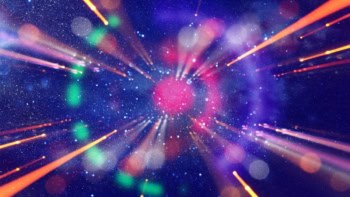
Physicists working at the Daya Bay Reactor Neutrino Experiment in China have made the best measurement so far of a key property of neutrinos – the “mixing angle” θ13, which describes the relationship between certain flavour and mass states of neutrinos. The experiment measured sin22θ13 by working out the rate at which electron antineutrinos vanish after being produced in several nuclear reactors. The researchers found sin22θ13 to be 0.092 with a statistical significance of 5.2σ – a high level of certainty that is usually associated with a “discovery” in the particle-physics community.
The relatively large value for sin22θ13 should make it much easier to do long-baseline neutrino experiments, which could in turn provide important clues towards solving the mystery of why matter, rather than antimatter, dominates the universe. Daya Bay is a partnership between 19 Chinese and 16 US universities and is the largest international scientific facility to be built on Chinese soil. The first phase of the experiment was completed last year and this first value of sin22θ13 was derived from data obtained over 55 days starting in December last year.
Halls of success
Neutrinos come in three “flavours” – electron, muon and tau – with the neutrinos able to change, or “oscillate”, between the different types. However, physicists also believe that neutrinos can be described in terms of combinations of three mass states – m1, m2 and m3. Interference between these mass states gives rise to the observed oscillations of neutrino flavour – after a certain period of time, an electron neutrino could change into a muon or tau neutrino, for example.
Although physicists have measured many of the parameters that describe this flavour/mass system, uncertainty has reigned over θ13, which is a measure of how the m1 and m3 mass states are combined within the flavour states. Three other experiments – T2K in Japan, MINOS in the US and Double Chooz in France – have all made preliminary measurements of sin22θ13, each in different ways, obtaining values of 0.11, 0.04 and 0.086, respectively. While these measurements all have a much lower statistical significance than the Daya Bay result, they all agree to within experimental uncertainties.
The Chinese experiment detects electron antineutrinos produced via nuclear beta decay at two neighbouring facilities – the Daya Bay and Ling Ao power plants. It has six separate detectors, located in three different underground halls where they are shielded from cosmic radiation. One hall is relatively close to each of the Daya Bay and Ling Ao power plants, whereas the third is about 2 km away from both reactors. By comparing the antineutrino fluxes recorded near to the reactors with the flux measured further away, physicists can work out how the rate at which antineutrinos disappear as they travel through the Earth. This rate, along with known neutrino parameters, can be used to calculate sin22θ13.
“Although we’re still two detectors shy of the complete experimental design, we’ve had extraordinary success in detecting the number of electron antineutrinos that disappear as they travel from the reactors to the detectors 2 km away,” says Kam-Biu Luk of the University of California, Berkeley, who heads the US part of the team.
Matter–antimatter imbalance
Hervé de Kerret, who is spokesperson for the Double Chooz experiment, welcomes the new findings, calling them “a beautiful confirmation of our measurement”. He adds that the relatively large value of sin22θ13 bodes well for physicists planning to do long-baseline experiments that compare the properties of neutrinos to antineutrinos. One such project is the Long Baseline Neutrino Experiment (LBNE) proposed by physicists at Fermilab in the US. The LBNE will send neutrinos and antineutrinos over a distance of about 1300 km in order to look for a difference in their oscillation rates. Such a difference would violate the Standard Model of particle physics, which incorporates a fundamental symmetry between particles and antiparticles known as CP (“charge–parity”) symmetry.
Finding physics beyond the Standard Model would be exciting enough, but if CP violation were observed in neutrinos, it would suggest that these tiny, nearly massless particles could have tipped the balance between matter and antimatter in the early universe – thereby producing the matter-dominated universe we see today. Physicists at Daya Bay will be installing two new antineutrino detectors later this year, which should further boost the accuracy of the sin22θ13 value when the experiment starts taking data again.
The results are described in the preprint on arXiv.



